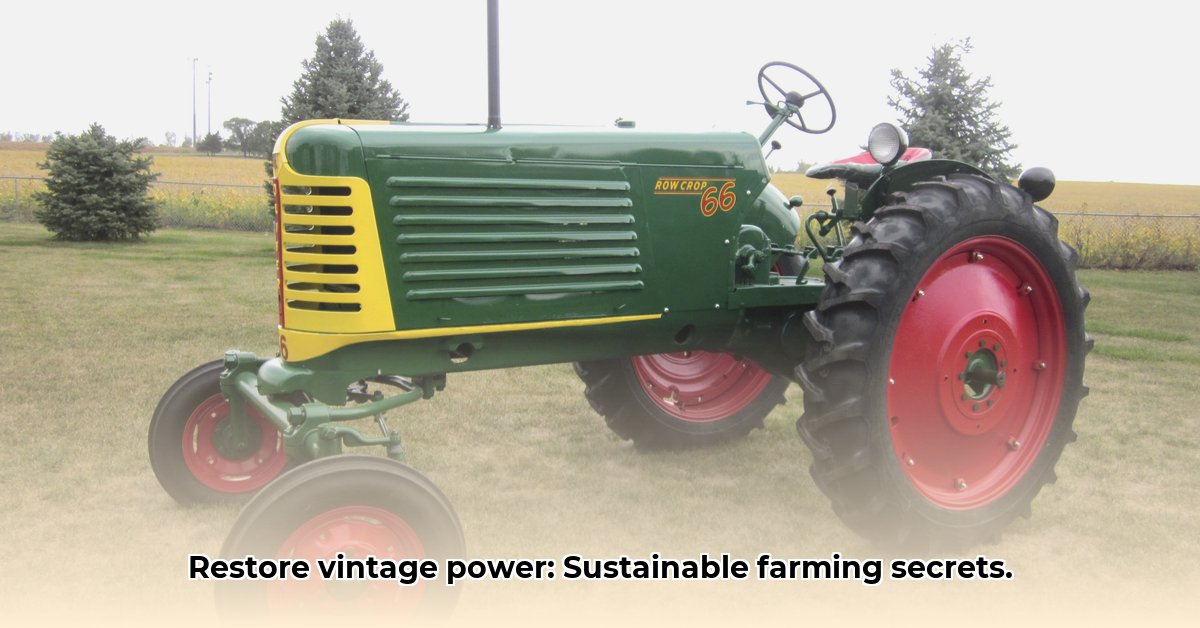
Bringing a piece of agricultural history to your farm offers a unique blend of charm and practicality. This guide explores the process of restoring and adapting a 1950 Oliver tractor for modern, sustainable farming practices. We will cover assessing its suitability, necessary retrofits, maintenance, and highlight the cost-benefit analysis to establish its viability within a contemporary farming context. This isn't just about restoring a tractor; it's about building a sustainable farming future. For more on classic tractor restoration, see this helpful resource.
Assessing Your 1950 Oliver Tractor: A Realistic Evaluation
Before embarking on a restoration project, a thorough assessment of your 1950 Oliver tractor is crucial. This involves weighing the advantages against the inherent challenges of using vintage machinery in modern agriculture.
Advantages:
- Simple Mechanics: The relatively simple mechanical design translates to easier maintenance and repairs, reducing reliance on specialized mechanics and potentially saving money. "The simplicity of these older tractors often allows for repairs with basic mechanical knowledge," says John Miller, a veteran agricultural engineer at Purdue University.
- Durability: 1950 Oliver tractors are renowned for their robust construction; with proper care, they can provide decades of reliable service, representing a long-term investment in sustainable farming.
- Environmental Friendliness: Utilizing a restored vintage tractor drastically reduces your carbon footprint compared to a new tractor, aligning with the principles of sustainable agriculture. "Using older, refurbished equipment is a critical part of reducing the environmental impact of farming," notes Dr. Sarah Chen, a sustainability expert at the University of California, Davis.
- Cost-Effectiveness (Potentially): The initial purchase price of a used 1950 Oliver is typically lower than a new tractor. However, this needs to be carefully weighed against potential repair costs and maintenance.
Disadvantages:
- Lower Horsepower: Compared to modern tractors, the horsepower is significantly lower, resulting in slower work rates, particularly impactful for large farms.
- Parts Sourcing: Finding replacement parts can be challenging, requiring the use of online forums, local salvage yards, and specialized parts dealers.
- Fuel Efficiency: These tractors generally exhibit lower fuel efficiency than modern counterparts, potentially increasing your fuel expenditure.
- Emissions Compliance: Older engines may not meet modern emission standards, necessitating potentially costly retrofits to comply with local regulations.
A comprehensive cost-benefit analysis, carefully considering purchase price, repair costs, fuel consumption, labor, and potential income generated, is essential for a data-driven decision. Is it realistic to expect this older model to perform efficiently enough to make up for these increased maintenance costs? Only a careful calculation can answer that.
Retrofitting Your 1950 Oliver Tractor: A Step-by-Step Guide
Retrofitting your 1950 Oliver involves a phased approach focused on enhancing its performance and sustainability, improving efficiency and reliability.
1. Parts Acquisition:
- Online Resources: Utilize online forums and communities dedicated to classic tractors for parts identification and sourcing.
- Salvage Yards: Explore local salvage yards – a treasure trove of potentially usable parts.
- Specialty Dealers: Consider specialized dealers, though at potentially higher costs.
2. Fuel Efficiency Enhancements:
- Carburetor Optimization: Professional carburetor tuning can significantly improve fuel economy.
- Biodiesel Exploration: Explore the possibility of using biodiesel, but ensure engine compatibility to prevent damage.
3. Emission Controls:
- Aftermarket Solutions: Explore aftermarket emission control systems suitable for your tractor and compliant with local ordinances.
4. Implement Upgrades:
- Compatibility Assessment: Confirm that intended implements are compatible with your tractor's hitch system.
5. Prioritizing Safety:
- Comprehensive Inspections: Conduct regular pre-operation safety checks.
- Protective Gear: Always wear appropriate protective gear during operation.
Maintenance and Operation: Ensuring Long-Term Sustainability
Regular maintenance is paramount for the longevity and efficient operation of your restored 1950 Oliver.
- Regular Oil Changes: Maintain consistent oil change intervals to prevent engine wear.
- Fluid Level Checks: Regularly monitor all fluid levels to ensure proper operation and avoid potential damage.
- Tire Pressure Maintenance: Consistent tire pressure is crucial for fuel efficiency, traction, and tire life.
- Lubrication: Regular lubrication of moving parts protects against excessive wear.
- Troubleshooting Preparedness: Familiarize yourself with common problems and develop troubleshooting skills.
Conclusion: The Sustainable Promise of a Restored Classic
The 1950 Oliver tractor, with careful restoration and ongoing maintenance, offers a pathway to sustainable agriculture. While it requires a commitment to learning and hands-on maintenance, the rewards, both economic and environmental, can be substantial for small-scale farming operations. This approach to farming reflects the values of many people seeking a more environmentally responsible life. The initial investment in time and resources can pay off for generations.